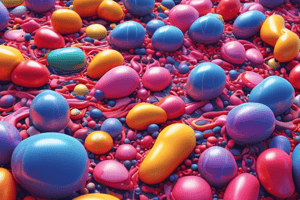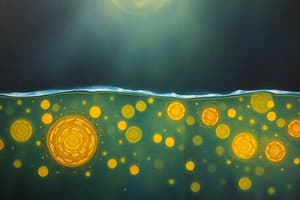Podcast
Questions and Answers
What is the primary function of the Na+/K+ pump in active transport?
What is the primary function of the Na+/K+ pump in active transport?
- To maintain the electrochemical gradients by pumping Na+ and K+ ions. (correct)
- To hydrolyze ATP for energy in passive transport mechanisms.
- To facilitate passive diffusion of ions across the membrane.
- To transport glucose and amino acids into the cell.
Which of the following best describes secondary active transport?
Which of the following best describes secondary active transport?
- The regulation of ion concentration solely through the Na+/K+ pump.
- Passive transport utilizing ion channels without energy input.
- Movement of substances against their concentration gradient coupled with Na+ flow. (correct)
- Transport of substances against their concentration gradient using direct ATP hydrolysis.
In the context of active transport, which mechanism requires ATP hydrolysis directly?
In the context of active transport, which mechanism requires ATP hydrolysis directly?
- Antiport transport mechanisms.
- Primary active transport mechanisms. (correct)
- Symport transport mechanisms.
- Secondary active transport mechanisms.
What is the outcome of the action of the Na+/K+ pump on ion distribution across the cell membrane?
What is the outcome of the action of the Na+/K+ pump on ion distribution across the cell membrane?
Which scenario exemplifies an antiport mechanism in secondary active transport?
Which scenario exemplifies an antiport mechanism in secondary active transport?
What feature of phospholipids makes them suitable for forming a bilayer in the plasma membrane?
What feature of phospholipids makes them suitable for forming a bilayer in the plasma membrane?
Which function of the cell membrane involves the use of glycoproteins and glycolipids?
Which function of the cell membrane involves the use of glycoproteins and glycolipids?
What is true about the fatty acid tails of phospholipids in the membrane?
What is true about the fatty acid tails of phospholipids in the membrane?
Which of the following is NOT a function of the plasma membrane?
Which of the following is NOT a function of the plasma membrane?
What effect does the aqueous environment have on the formation of the phospholipid bilayer?
What effect does the aqueous environment have on the formation of the phospholipid bilayer?
Which of the following phospholipids is known to be the most abundant in cell membranes?
Which of the following phospholipids is known to be the most abundant in cell membranes?
Which term describes the selective barrier property of the cell plasma membrane?
Which term describes the selective barrier property of the cell plasma membrane?
Which function of the cell membrane is primarily facilitated by proteins embedded within the bilayer?
Which function of the cell membrane is primarily facilitated by proteins embedded within the bilayer?
Which factor contributes to increased membrane fluidity?
Which factor contributes to increased membrane fluidity?
What is the function of cholesterols in the plasma membrane?
What is the function of cholesterols in the plasma membrane?
Which lipid is primarily found on the cytosolic side and is crucial for activating protein kinase C?
Which lipid is primarily found on the cytosolic side and is crucial for activating protein kinase C?
What characteristic differentiates integral membrane proteins from peripheral membrane proteins?
What characteristic differentiates integral membrane proteins from peripheral membrane proteins?
Which function do receptors on transmembrane proteins serve?
Which function do receptors on transmembrane proteins serve?
How does facilitated diffusion differ from active transport?
How does facilitated diffusion differ from active transport?
What is a characteristic of membrane asymmetry?
What is a characteristic of membrane asymmetry?
Which type of protein is involved in transport across membranes?
Which type of protein is involved in transport across membranes?
What is the role of glycoproteins in the membrane?
What is the role of glycoproteins in the membrane?
Which of the following statements incorrectly describes peripheral membrane proteins?
Which of the following statements incorrectly describes peripheral membrane proteins?
What happens during apoptosis related to phosphatidylserine?
What happens during apoptosis related to phosphatidylserine?
Which of the following correctly describes facilitated diffusion?
Which of the following correctly describes facilitated diffusion?
What is the impact of fatty acid saturation on membrane fluidity?
What is the impact of fatty acid saturation on membrane fluidity?
What is the primary role of transport proteins in the plasma membrane?
What is the primary role of transport proteins in the plasma membrane?
Flashcards
Primary Active Transport
Primary Active Transport
A type of active transport that uses energy directly from ATP hydrolysis to move substances against their concentration gradient.
Na+/K+ pump
Na+/K+ pump
A key example of primary active transport. It pumps 3 Na+ ions out of the cell and 2 K+ ions into the cell.
Secondary Active Transport
Secondary Active Transport
A type of active transport that indirectly uses energy from ATP hydrolysis. It couples the movement of one substance down its concentration gradient with the movement of another substance against its concentration gradient.
Symport
Symport
Signup and view all the flashcards
Antiport
Antiport
Signup and view all the flashcards
What is the cell membrane?
What is the cell membrane?
Signup and view all the flashcards
What is a phospholipid?
What is a phospholipid?
Signup and view all the flashcards
How do phospholipids form a membrane?
How do phospholipids form a membrane?
Signup and view all the flashcards
What does 'selectively permeable' mean?
What does 'selectively permeable' mean?
Signup and view all the flashcards
Why is cell recognition important?
Why is cell recognition important?
Signup and view all the flashcards
What is the role of membrane potential?
What is the role of membrane potential?
Signup and view all the flashcards
How do enzymes function in the cell membrane?
How do enzymes function in the cell membrane?
Signup and view all the flashcards
What is the role of the cell membrane in communication?
What is the role of the cell membrane in communication?
Signup and view all the flashcards
Membrane Fluidity
Membrane Fluidity
Signup and view all the flashcards
Facilitated Diffusion
Facilitated Diffusion
Signup and view all the flashcards
Active Transport
Active Transport
Signup and view all the flashcards
Transmembrane Protein
Transmembrane Protein
Signup and view all the flashcards
Single-pass Transmembrane Protein
Single-pass Transmembrane Protein
Signup and view all the flashcards
Multi-pass Transmembrane Protein
Multi-pass Transmembrane Protein
Signup and view all the flashcards
B-barrel Protein
B-barrel Protein
Signup and view all the flashcards
Lipid-linked Proteins
Lipid-linked Proteins
Signup and view all the flashcards
Peripheral Membrane Proteins
Peripheral Membrane Proteins
Signup and view all the flashcards
Receptor Function
Receptor Function
Signup and view all the flashcards
Membrane Asymmetry
Membrane Asymmetry
Signup and view all the flashcards
Phosphatidylserine
Phosphatidylserine
Signup and view all the flashcards
Phosphatidylinositol
Phosphatidylinositol
Signup and view all the flashcards
Glycolipids
Glycolipids
Signup and view all the flashcards
Anchoring Proteins
Anchoring Proteins
Signup and view all the flashcards
Study Notes
Cell Plasma Membrane Structure and Function
- The cell plasma membrane is a selectively permeable barrier, protecting the cell's interior.
- Composed of a lipid bilayer with embedded proteins.
- Each lipid molecule has a hydrophobic tail and a hydrophilic head.
- The bilayer's formation is energetically favorable in aqueous environments. The closed, round shape minimizes exposure of hydrophobic tails to water.
Cell Membrane Functions
- Cell recognition: Glycolipids and glycoproteins identify cells to the immune system.
- Intracellular environment: Maintains membrane potential.
- Protection: Acts as a barrier.
- Transport: Proteins facilitate ion movement.
- Catalytic function: Enzymes embedded within the bilayer catalyze reactions.
- Cellular communication: Signal transduction occurs through the membrane.
Phospholipids
- The most abundant lipids in cell membranes.
- Examples include phosphatidylcholine, phosphatidylserine, phosphatidylethanolamine, phosphatidylinositol, and sphingomyelin.
- Amphipathic: Possess both hydrophobic (fatty acid tails) and hydrophilic (phosphate head) regions.
- Fatty acid chains vary in length (12-20 carbons). Often one saturated, one unsaturated.
Membrane Fluidity
- The membrane is fluid, allowing for lateral diffusion of lipids and proteins.
- Crucial for cell signaling, cell division, and membrane fusion.
- Factors affecting fluidity:
- Shorter fatty acid chains increase fluidity.
- More unsaturated fatty acid chains enhance fluidity
- Cholesterol decreases fluidity by restricting movement of other molecules. Cholesterol's structure consists of four hydrophobic rings and a small polar region.
Membrane Asymmetry
- Lipid composition on the intracellular and extracellular faces differs.
- More phosphatidylserine on the cytosolic side. Phosphatidylserine's movement to the extracellular side signals apoptosis.
- Phosphatidylinositol and other signaling lipids are on the cytosolic side.
- Glycolipids are exclusively on the extracellular side.
Membrane Proteins
- Integral proteins: Permanently embedded in the bilayer, often transmembrane proteins.
- Transmembrane proteins can be single-pass alpha-helices, multiple-pass alpha-helices, or beta-barrels.
- Or lipid-linked.
- Peripheral proteins: Non-covalently bound to the membrane, easily removed.
Membrane Protein Functions
- Transporters: Channels and carrier proteins facilitate movement across the membrane.
- Anchors: Integrins link ECM to the cytoskeleton, aiding motility.
- Receptors: Bind ligands, transmitting signals.
- Glycoproteins: Cell-cell recognition.
- Enzymes: Catalyze reactions.
- Intracellular joining: Joins cells together (e.g., gap junctions).
- Signal transduction molecules: Amplify and pass on signals.
Transport Across Membranes
- Facilitated diffusion: Passive movement down a concentration gradient using proteins (channels or uniporters). Large or polar molecules needing assistance.
- Active transport: Movement against a concentration gradient, requiring ATP.
- Primary active transport: Directly uses ATP hydrolysis. Example: Na+/K+ pump.
- Secondary active transport: Uses the gradient established by primary active transport (e.g., Na+ gradient). Can be symport (same direction) or antiport (opposite direction).
Studying That Suits You
Use AI to generate personalized quizzes and flashcards to suit your learning preferences.




